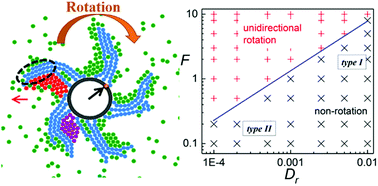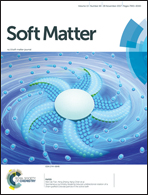Spontaneous symmetry breaking induced unidirectional rotation of a chain-grafted colloidal particle in the active bath†
Abstract
Exploiting the energy of randomly moving active agents such as bacteria is a fascinating way to power a microdevice. Here we show, by simulations, that a chain-grafted disk-like colloidal particle can rotate unidirectionally and hence output work when immersed in a thin film of active particle suspension. The collective spontaneous symmetry breaking of chain configurations is the origin of the unidirectional rotation. Long persistence time, large propelling force and/or small rotating friction are keys to sustaining the collective broken symmetry and realizing the rotation. In the rotating state, we find very simple linear relations, e.g. between the mean angular speed and the propelling force. The time-evolving asymmetry of chain configurations reveals that there are two types of non-rotating state. The basic phenomena are also observed in the macroscopic granular experiments, implying the generic nature of these phenomena. Our findings provide new insights into the collective spontaneous symmetry breaking in active systems with flexible objects and also open the way to conceive new soft/deformable microdevices.



 Please wait while we load your content...
Please wait while we load your content...